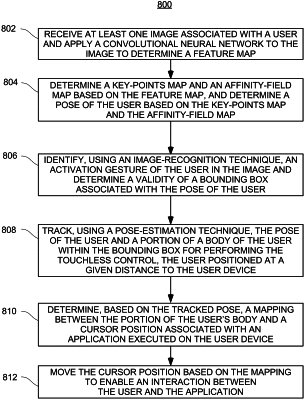| CPC G06F 3/017 (2013.01) [G06F 3/04812 (2013.01); G06F 3/04815 (2013.01); G06N 3/08 (2013.01); G06T 7/73 (2017.01); G06V 40/28 (2022.01)] | 17 Claims |

|
1. A device for performing touchless control, comprising:
at least one memory device that stores computer-executable instructions; and
at least one processor configured to access the memory device, wherein the processor is configured to execute the computer-executable instructions to:
receive at least one image from at least one camera;
apply a machine learning technique to the image to determine a first map, the first map comprising a function that generates a correspondence between data associated with the image to a feature space;
determine a second map comprising a representation of a user in the image based on the first map;
determine a third map comprising a vector field that encodes key-point to key-point relationships in the image;
determine a pose of the user based on the second map and the third map by predicting, via the machine learning technique, a body part confidence associated with a portion of a body of the user;
identify a gesture of the user in the image based on the pose of the user;
track the pose of the user and the portion of the body of the user for performing touchless control of the device to generate a historical data of the pose and the portion of the body of the user;
determine, based on the tracked pose, a mapping between the portion of the user's body and an input feature associated with the device;
modify the input feature to a first location based on the mapping to enable an interaction between the user and the device; and
modify the input feature to a second location different from the first location based on the historical data in addition to the mapping.
|